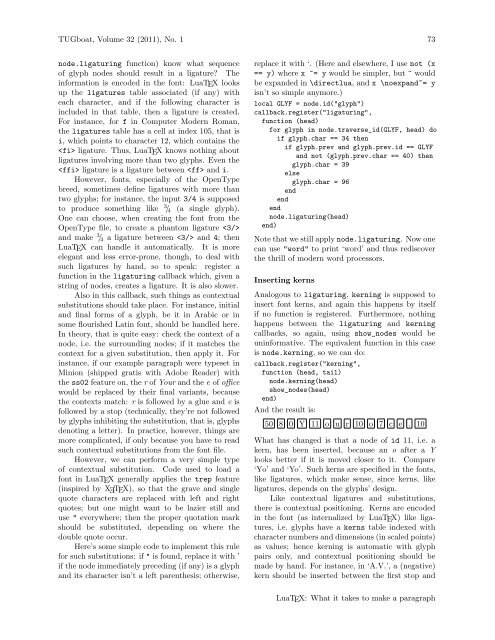LuaTEX: What it takes to make a paragraph Paul Isambert ... - TUG
LuaTEX: What it takes to make a paragraph Paul Isambert ... - TUG
LuaTEX: What it takes to make a paragraph Paul Isambert ... - TUG
You also want an ePaper? Increase the reach of your titles
YUMPU automatically turns print PDFs into web optimized ePapers that Google loves.
<strong>TUG</strong>boat, Volume 32 (2011), No. 1 73<br />
node.ligaturing function) know what sequence<br />
of glyph nodes should result in a ligature? The<br />
information is encoded in the font: <strong>LuaTEX</strong> looks<br />
up the ligatures table associated (if any) w<strong>it</strong>h<br />
each character, and if the following character is<br />
included in that table, then a ligature is created.<br />
For instance, for f in Computer Modern Roman,<br />
the ligatures table has a cell at index 105, that is<br />
i, which points <strong>to</strong> character 12, which contains the<br />
ligature. Thus, <strong>LuaTEX</strong> knows nothing about<br />
ligatures involving more than two glyphs. Even the<br />
ligature is a ligature between and i.<br />
However, fonts, especially of the OpenType<br />
breed, sometimes define ligatures w<strong>it</strong>h more than<br />
two glyphs; for instance, the input 3/4 is supposed<br />
<strong>to</strong> produce something like 3 / 4 (a single glyph).<br />
One can choose, when creating the font from the<br />
OpenType file, <strong>to</strong> create a phan<strong>to</strong>m ligature <br />
and <strong>make</strong> 3 / 4 a ligature between and 4; then<br />
<strong>LuaTEX</strong> can handle <strong>it</strong> au<strong>to</strong>matically. It is more<br />
elegant and less error-prone, though, <strong>to</strong> deal w<strong>it</strong>h<br />
such ligatures by hand, so <strong>to</strong> speak: register a<br />
function in the ligaturing callback which, given a<br />
string of nodes, creates a ligature. It is also slower.<br />
Also in this callback, such things as contextual<br />
subst<strong>it</strong>utions should take place. For instance, in<strong>it</strong>ial<br />
and final forms of a glyph, be <strong>it</strong> in Arabic or in<br />
some flourished Latin font, should be handled here.<br />
In theory, that is qu<strong>it</strong>e easy: check the context of a<br />
node, i.e. the surrounding nodes; if <strong>it</strong> matches the<br />
context for a given subst<strong>it</strong>ution, then apply <strong>it</strong>. For<br />
instance, if our example <strong>paragraph</strong> were typeset in<br />
Minion (shipped gratis w<strong>it</strong>h Adobe Reader) w<strong>it</strong>h<br />
the ss02 feature on, the r of Your and the e of office<br />
would be replaced by their final variants, because<br />
the contexts match: r is followed by a glue and e is<br />
followed by a s<strong>to</strong>p (technically, they’re not followed<br />
by glyphs inhib<strong>it</strong>ing the subst<strong>it</strong>ution, that is, glyphs<br />
denoting a letter). In practice, however, things are<br />
more complicated, if only because you have <strong>to</strong> read<br />
such contextual subst<strong>it</strong>utions from the font file.<br />
However, we can perform a very simple type<br />
of contextual subst<strong>it</strong>ution. Code used <strong>to</strong> load a<br />
font in <strong>LuaTEX</strong> generally applies the trep feature<br />
(inspired by X TEX), so that the grave and single<br />
quote characters are replaced w<strong>it</strong>h left and right<br />
quotes; but one might want <strong>to</strong> be lazier still and<br />
use " everywhere; then the proper quotation mark<br />
should be subst<strong>it</strong>uted, depending on where the<br />
double quote occur.<br />
Here’s some simple code <strong>to</strong> implement this rule<br />
for such subst<strong>it</strong>utions: if " is found, replace <strong>it</strong> w<strong>it</strong>h ’<br />
if the node immediately preceding (if any) is a glyph<br />
and <strong>it</strong>s character isn’t a left parenthesis; otherwise,<br />
E<br />
replace <strong>it</strong> w<strong>it</strong>h ‘. (Here and elsewhere, I use not (x<br />
== y) where x ~= y would be simpler, but ~ would<br />
be expanded in \directlua, and x \noexpand~= y<br />
isn’t so simple anymore.)<br />
local GLYF = node.id("glyph")<br />
callback.register("ligaturing",<br />
function (head)<br />
for glyph in node.traverse_id(GLYF, head) do<br />
if glyph.char == 34 then<br />
if glyph.prev and glyph.prev.id == GLYF<br />
and not (glyph.prev.char == 40) then<br />
glyph.char = 39<br />
else<br />
glyph.char = 96<br />
end<br />
end<br />
end<br />
node.ligaturing(head)<br />
end)<br />
Note that we still apply node.ligaturing. Now one<br />
can use "word" <strong>to</strong> print ‘word’ and thus rediscover<br />
the thrill of modern word processors.<br />
Inserting kerns<br />
Analogous <strong>to</strong> ligaturing, kerning is supposed <strong>to</strong><br />
insert font kerns, and again this happens by <strong>it</strong>self<br />
if no function is registered. Furthermore, nothing<br />
happens between the ligaturing and kerning<br />
callbacks, so again, using show_nodes would be<br />
uninformative. The equivalent function in this case<br />
is node.kerning, so we can do:<br />
callback.register("kerning",<br />
function (head, tail)<br />
node.kerning(head)<br />
show_nodes(head)<br />
end)<br />
And the result is:<br />
50 8 0 Y 11 o u r 10 o 7 c e . 10<br />
<strong>What</strong> has changed is that a node of id 11, i.e. a<br />
kern, has been inserted, because an o after a Y<br />
looks better if <strong>it</strong> is moved closer <strong>to</strong> <strong>it</strong>. Compare<br />
‘Yo’ and ‘Yo’. Such kerns are specified in the fonts,<br />
like ligatures, which <strong>make</strong> sense, since kerns, like<br />
ligatures, depends on the glyphs’ design.<br />
Like contextual ligatures and subst<strong>it</strong>utions,<br />
there is contextual pos<strong>it</strong>ioning. Kerns are encoded<br />
in the font (as internalized by <strong>LuaTEX</strong>) like ligatures,<br />
i.e. glyphs have a kerns table indexed w<strong>it</strong>h<br />
character numbers and dimensions (in scaled points)<br />
as values; hence kerning is au<strong>to</strong>matic w<strong>it</strong>h glyph<br />
pairs only, and contextual pos<strong>it</strong>ioning should be<br />
made by hand. For instance, in ‘A.V.’, a (negative)<br />
kern should be inserted between the first s<strong>to</strong>p and<br />
<strong>LuaTEX</strong>: <strong>What</strong> <strong>it</strong> <strong>takes</strong> <strong>to</strong> <strong>make</strong> a <strong>paragraph</strong>

















